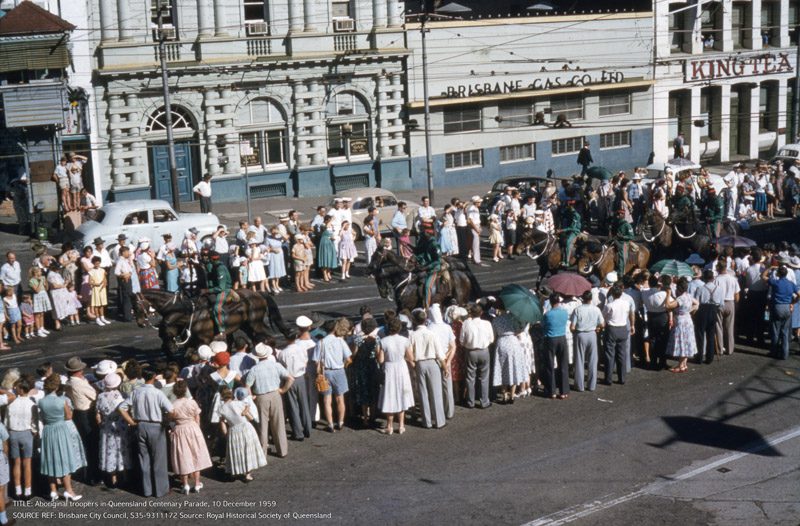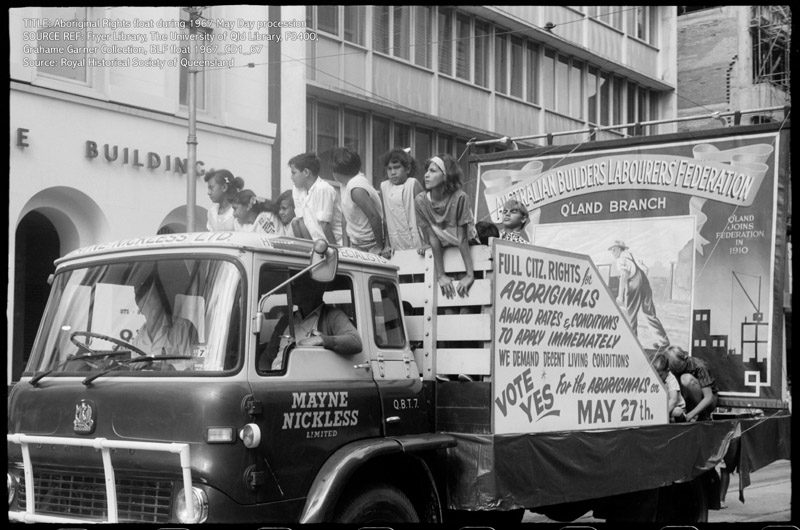Memory Lane – Lift East Wall
Aboriginal troopers in Queensland Centenary Parade – 10 December 1959
Yugara Country
The Queensland Native Mounted Police operated for over 50 years, from 1849 until 1904. It was organised along paramilitary lines, consisting of detachments of Aboriginal troopers led by white officers. It operated across the whole of Queensland and was explicitly constituted to protect the lives, livelihoods and property of settlers.
Aboriginal Rights float during the 1967 May Day Procession, Australian Builders Labourers Federation Float
Yugara Country
The Australian Builders Labourers Federation adopted the cause for a YES vote on this float in Brisbane in relation to the Aboriginal campaign for the forthcoming referendum to be held on 27 May 1967. A YES vote in the referendum would result in the removal of two references in the Constitution which discriminated against Aboriginal people.
Although Aboriginal people did have voting rights prior to the referendum with legislation by the Commonwealth in 1962, Queensland was the last jurisdiction to legislate for this in 1965. The 90.77 percent YES vote in the 1967 referendum was the highest ever recorded in a Federal referendum, allowing Aboriginals to be counted in the national census and to give the Commonwealth powers to make special laws for the benefit of Aboriginals. Mani’ Aboriginal people considered this change gave them formal recognition of their existence in their own country.
Oodgeroo Noonuccal and Pastor Don Brady watching dancers in King George Square – 1970s
Yugara Country
Pastor Don Brady, holding his didgeridoo, stands with Oodgeroo Noonuccal (on his right) watching young Aboriginal dancers. He was supporting expressions of Indigenous culture in this public square with groups such as the Kuku Yalanji, the Pastor’s traditional people. Their objective was to promote Aboriginal and Torres Strait Islander culture in an effort to preserve the cultures of Indigenous inhabitants. Brady trained as a missionary prior to studying at the Methodist Training College in Brisbane and was appointed a lay pastor in 1964. His ministry was urban dwelling Aboriginals.
After travelling to the US on a Churchill fellowship in 1968, he became an advocate for Indigenous rights. With other members of the National Tribal Council, formed in Brisbane in 1970, which included Kath Walker (Oodgeroo Noonuccal) and her son Dennis, Brady became a part of a core political leadership in the Brisbane black movement’. Oodgeroo Noonuccal, one of Australia’s leading literary figures, was a prominent campaigner in the Indigenous struggle for rights and justice. They both continued this long struggle for justice throughout their lives. Brady was released of his spiritual mission in 1972 and appointed to a position of liaison officer for the welfare of Aboriginal people.
Fryer Library, The University of Queensland Library, F3400, Grahame Garner Collection, BLF.
Map representing the language, social or nation groups of Aboriginal Australia
Link to image can be found on the AIATSIS website.
This map attempts to represent the language, social or nation groups of Aboriginal Australia. It shows only the general locations of larger groupings of people which may include clans, dialects or individual languages in a group. It’s used published resources from the eighteenth century – 1994 and is not intended to be exact, nor boundaries fixed. It is not suitable for native title or other land claims.
David R Horton (creator) ©, AIATSIS, 1996.



